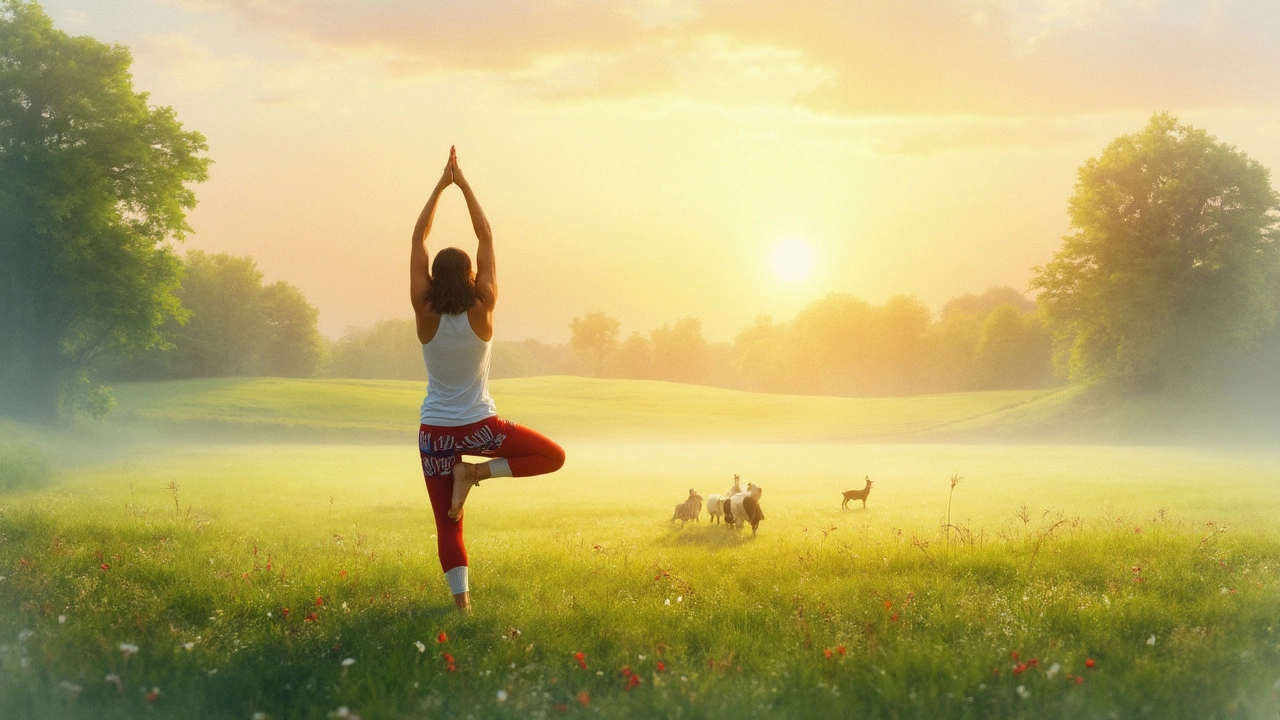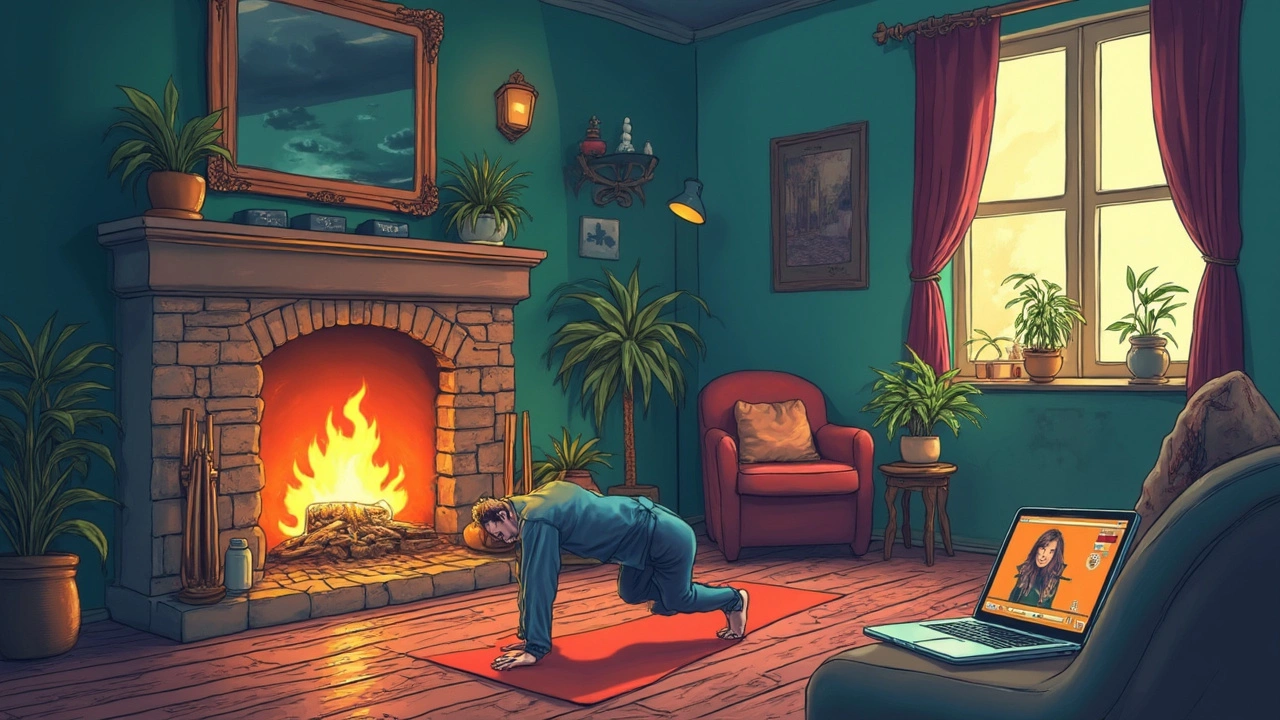
Yoga at home without an instructor? Sounds freeing, right? But is it a smart move? Many people dive into the world of solo yoga because it's super convenient – you can practice whenever suits you, in your pajamas if you want! But hold on, before you roll out that mat in your living room, let’s weigh what you're getting into.
First off, there are definitely perks. Think of the flexibility and comfort of practicing yoga in your own space. You're not confined to class schedules, and there's no commute cutting into your zen time. Plus, solo yoga allows for a bit of personal experimentation. You can focus on the poses and sequences that feel right for you, adjusting them according to your mood and energy.
So, what makes solo yoga practice so appealing? It’s not hard to see why many are attracted to rolling out their yoga mats without an instructor guiding every move.
Freedom and Flexibility are perhaps the most significant draws. You can do yoga anytime and anywhere, whether it's early in the morning or late at night, in your living room or at the park. No need to rush to a studio or stick to someone else's schedule. It’s all about you and what fits into your life.
Another big perk is personalization. Not all yoga routines resonate with everyone, and practicing alone means tailoring your routines to what your body needs and how it feels. You can focus on poses that target specific areas, skip those that don't serve you, or even create your own sequences!
Forget those pricey class packages. Practicing yoga solo drastically cuts down costs. All you really need is a mat and maybe some props you can easily find around the house. Plus, a world of free online resources and videos is literally at your fingertips.
Let’s be real – not all of us feel confident showing off our downward dog in a crowded class. At home, you can try new poses, breathe loudly, and just be yourself without worrying about what others might think. It's a safe space for you to grow your practice with ease.
Many also find that solo practice fosters a deeper sense of mindfulness. Without the distraction of others, you can tune into your own breath and body, being present in every pose and every moment.
Stats Worth Noting:
| Aspect | Value |
|---|---|
| Average cost of a yoga class | $15 - $25 |
| Potential savings per year | $500 - $1500 |
Diving into yoga on your own without an instructor can feel like a big adventure, but it's not without its pitfalls. Let's talk about what you might face. Practicing solo might lead to adopting incorrect postures or techniques, all because there’s no one there to correct you. This can potentially lead to injuries over time, especially in poses that require alignment precision.
One of the major risks is overdoing it. When no instructor is present to guide or stop you, it's easy to push beyond your limits. Especially in complex poses, trying too hard might strain muscles or joints. Pain is your body's way of saying something isn’t right, so if you're feeling it, ease up!
A qualified yoga coach tailors a routine specific to your needs, experience, and body type. When going it alone, you might not achieve the same level of personalization. The lack of immediate feedback could also mean that you miss subtle signs from your body that need addressing.
Then there's the mental side of things. It’s easy to get distracted at home – the phone rings, your pet wants attention, or the laundry calls your name. Your focus can waver, leading to less effective sessions. Yoga is as much about the mind as the body, and distractions can take away from its benefits.
While it’s liberating to have control over your practice, weigh these risks carefully. Consider starting with classes, even if they're virtual, where faced with guidance to ensure you're on the right path in your solo yoga routines.
Embarking on a yoga journey by yourself can be super rewarding. Let's talk about some of the cool benefits that come with it!
When you practice solo yoga, you're in charge of your timetable. No need to rush to catch a class. You can do it in the morning, during lunch, or even late at night when the world is asleep. This flexibility means yoga fits into your life, not the other way around.
Practicing on your own helps build discipline. Without an instructor there to guide you, you learn to motivate yourself. It might be tough at first, but over time, this self-discipline spills over into other parts of your life, too. It's like strengthening a muscle; the more you use it, the stronger it gets.
When you’re not in a group setting, you have the luxury to tailor your yoga routines. Maybe one day you're into more restorative poses, and the next, you're feeling energetic enough for some intense vinyasa flows. It's your choice, and it’s all about what your body needs.
Being alone on the mat can improve mindfulness. There's no one to compare yourself to, which means you're likely to focus more on your breath, your body, and the present moment. It's a great way to delve deeper into the practice of yoga itself, fostering a deeper connection with yourself.
With all these benefits, solo home yoga appears pretty appealing, right? Just remember to stay aware of your form and safety to maximize these advantages!

Diving into yoga without an instructor sounds appealing, but it's easy to slip up if you're not careful. Let's cut to the chase and talk about some common mistakes folks make when practicing solo yoga.
It feels tempting to jump right into your favorite poses, but skipping a good warm-up is a no-go. A few minutes of stretching and breathing can get your muscles ready and prevent injuries. It’s like coffee before you start your day!
Without an instructor to guide you, proper form might go out the window. This can lead to strains and a messy routine. Consider using mirrors to check your alignment or filming yourself to spot mistakes.
Your body has a voice, and ignoring it is a big mistake. If a pose doesn’t feel right, it’s okay to skip it or modify. Nobody’s watching, so honor your limits.
Advanced doesn’t always mean better, especially if you’re not ready. Stick to poses that fit your current level to avoid injuries. The journey in yoga is more important than the destination.
Consistency is key. It’s easy to let other tasks eat up your solo yoga practice time. Set a schedule and stick to it; regular practice brings the best results.
Breath and yoga routines go hand in hand. Forgetting to focus on breathing can limit your progress. Practice mindful breathing with each pose, promoting relaxation and deeper stretches.
Try technology as a helpful buddy. There are plenty of apps and online videos that can guide you and help you spot errors in your solo yoga routines.
Remember, practicing yoga alone gives you freedom, but it's important to maintain awareness and discipline to make the most of it!
When you're practicing yoga without an instructor, having the right resources can be like having a GPS for your spiritual and physical journey. But with so much out there, how do you know what will actually guide you well?
There are a few solid platforms that offer quality yoga routines. Websites like Yoga Journal and DoYogaWithMe have fantastic guided videos and detailed pose breakdowns. They offer variations so you don't get bored and can advance at your own pace.
If you're more of an app person, check out Down Dog or Glo. These apps not only offer great visual aids and audio instructions but also let you customize your practice by length and difficulty level, almost like having a virtual instructor in your pocket.
Never underestimate the power of a good book. "Light on Yoga" by B.K.S. Iyengar is a classic guide with detailed explanations. Also, consider yoga podcasts, like The Yoga Hustle, for insights while you're relaxing off the mat.
Sometimes it helps to chat with others. Online yoga forums and Facebook groups can be an excellent place to share progress, ask questions, and get recommendations from like-minded folks on solo yoga practices.
Before diving into content, it’s wise to check if the resources come from certified, experienced instructors. Look for qualifications and reviews to ensure what you’re accessing is both safe and informed.
With reliable resources in your toolkit, your solo yoga session can be just as beneficial as (if not sometimes more so than) a studio class!
Diving into solo yoga can be a rewarding experience if you go about it wisely. Here's how to make the most of your at-home sessions.
One of the upsides of practicing at home is flexibility, but that doesn't mean you should skip consistency. Try to carve out a routine and stick to it. Whether it's a 20-minute morning flow or a winding down sequence before bed, regularity helps build discipline and makes yoga a natural part of your day.
While you don't need to transform your living room into a yoga studio, having a dedicated spot matters. Ensure it's clutter-free and quiet. Add some calming elements such as a candle or a small plant to invite some good vibes.
We're in the age of apps and videos, so take advantage of them. There are tons of yoga platforms offering classes for every level. Platforms like Yoga with Adriene or Down Dog can guide your sessions, giving you a virtual instructor's expertise without leaving home.
One of the most crucial things in solo practice is tuning into your body's signals. Without an instructor's immediate feedback, it's essential to pay attention to how a pose feels. If something hurts or doesn't feel right, ease off or try a modification.
Having an outline of what you want to achieve on the mat helps keep you focused. But remember, yoga is also about listening to what you need in the moment. If today's session needs more stretching than strength work, go with that. Adapt as necessary.
By integrating these tips, you're creating a yoga routine that not only fits your lifestyle but nurtures your progression over time. Happy practicing!